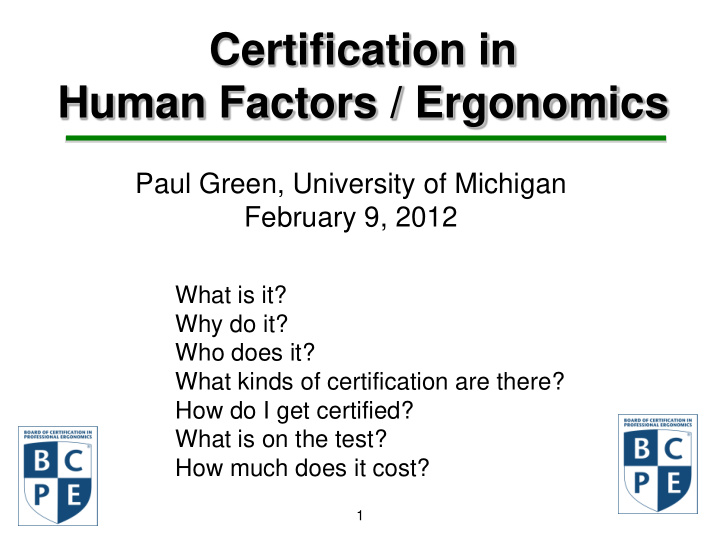



Certification in Human Factors / Ergonomics Paul Green, University of Michigan February 9, 2012 What is it? Why do it? Who does it? What kinds of certification are there? How do I get certified? What is on the test? How much does it cost? 1
What is certification? Designation to assure a person is qualified to perform a job or task (per wikipedia) Corporate, product, or profession but not HFES due to conflict of interest concerns CPA, pilot, med, law, PE (MD, RN, specialties), CSP Elements: Experience & service, work products, degrees, tests, fees 2
There are at least 5 reasons to become certified . 1. May be required to apply for a job. • Companies recognizing BCPE ’ s credentials include: - Amazon Fulfillment Svcs. - Kohler Company - AON Risk Services - Library of Congress - Coca-Cola Refreshments - Raytheon - Exxon Biomedical Sciences - US Navy - Ford Motor Company - Wells Fargo Ins. 3
The other 4 reasons 2. Helps you when applying for a job. – distinguishes your resume from others 3. Better prepares you for a job (going through the process will give you knowledge and skills you need to do well) 4. Strengthens your position in discussion when opinions matter (Yes, we are both humans, but I ’ m a certified human factors professional, are you?) 5. Strengthens the profession by assuring those who do the work are qualified (weaker reason) 4
BCPE certifies in the US & elsewhere (Brazil, Malaysia,…) • US & elsewhere -> Board of Certification in Professional Ergonomics (BCPE) • Europe -> Centre for the Registration of European Ergonomists (CREE) • Japan -> JES Certification Program in Professional Ergonomics
BCPE oversees professional certification in Ergonomics Human Factors User Experience ~1500 certified since 1990 6
BCPE is… • accredited for the CPE, CHFP, CUXP credentials by National Commission for Certifying Agencies (NCCA) • member of the Institute for Credentialing Excellence (ICE formerly NOCA). • recognized by the International Ergonomics Association (IEA) as an accredited ergonomics certification organization. • reciprocity agreement with CREE, Centre for Registration of European Ergonomists. • recognized by the American Board of Industrial Hygiene (ABIH) as the premier certifying body for the HF/Ergo/UX 7
There are several categories of certification. 1. Certified Professional Ergonomist (CPE) or Certified Human Factors Professional (CHFP) or Certified User Experience Professional (CUXP) Associate Ergonomics Professional (AEP) or Associate Human Factors Professional (AHFP) Associate User Experience Professional (AUXP): a step toward the CPE or CHFP or CUXP….. 2. Certified Ergonomics Associate (CEA) 8
There are 4 key elements to BCPE certification. Education (degree) Experience Test Fees 9
CPE/CHFP/CUXP Certification Criteria 1. Degree: Master ’ s degree or equivalent in human factors / ergonomics or a closely related field. (recognized HFES/IEA program) 2. Experience: 3 years full-time professional practice in human factors/ergonomics. Graduates of a recognized HF/Ergo PhD program get a credit of work experience. Document on forms (resume, work history, work samples, etc.) 3. Test: Passing score on the CPE/CHFP/CUXP written test. Graduates of a HF/E program accredited by an IEA Federated Society (e.g., HFES, IEHF) are not required to take Part I of the test. 10
And you need to stay current Continuance of Certification • CPEs/CHFPs/CUXPs must complete a worksheet documenting 100 points every 5 years. • Categories: (1) Active practice; (2) Training (receiving or give); (3) Service to societies, committees or stds development; (4) publishing; (5) Go to/participate in professional meetings/ conferences. • must have points in >= 2 / 5 categories. • http://www.bcpe.org/page/coc-worksheet - more info 11
AEP/AHFP/AUXP Certification Criteria (CPE/CHFP/CUXP in progress) • Degree: Meets the educational requirement (masters) for CPE/CHFP/ CUXP certification. • Experience: working toward fulfilling the CPE/CHFP/CUXP requirement of 3 years full- time professional practice. (1 year for HF/E PhD program) Document on forms • Form: Completes and submits an approved AEP/AHFP/AUXP application. 12
CEA Certification Criteria (for nontraditional practitioner) • Degree: bachelor ’ s degree from an accredited university >= 200 hr of ergo training (can include degree coursework) • Experience: >= 2 yr full time practice in ergo • Test: passing score
What is on the test? The Ergonomist Formation Model A. Ergonomics Principles 1. Ergonomics Approach 2. Systems Theory B. Human Characteristics 1. Anatomy, Demographics and Physiology 2. Human Psychology 3. Social and Organizational Aspects 4. Physical Environments C. Work Analysis and Measurement 1. Statistics and Experimental Design 2. Computation and Information Technology 14
The Ergonomist Formation Model C. Work Analysis and Measurement Continued 3. Instrumentation 4. Methods of Measurement and Investigation 5. Work Analysis D. People and Technology 1. Technology 2. Human Reliability 3. Health, Safety and Well-Being 4. Training and Instruction 5. Occupational Hygiene 6. Workplace Design*** 15
The Ergonomist Formation Model D. People and Technology Continued 7. Information Design*** 8. Work Organization Design*** E. Applications (projects pursued by the individual during education/training) F. Professional Issues (ethics, practice standards, marketing, business practice, legal liabilities) *** CPEs must be competent in at least one design domain 16
Other test details • ½ - 1 day to complete • Given several times / year (HFES, Applied Ergo) • Creation process organizer assign topics to experts gets draft Q back (with refs) review questions, toss some, get more send test Q pool to review board they accept, reject, or request changes
How to prepare for the test • Get BCPE study guide (candidate handbook) with list of books and sample questions • Read them • Review your class notes • Form a study group (not easy)
Think of certification fees as an investment. Application AEP/AHFP/AUXP $50/$100 CPE/CHFP/CUXP $125 CEA $125 Test AEP to CPE $250 CPE/CHFP/CUXP $250 CEA $200 Maintenance (annual) AEP/AHFP/AUXP $90 CPE/CHFP/CUXP $135 CEA $100 More info: http://www.bcpe.org/page/certification-fees
Q? .org 20
Recommend
More recommend